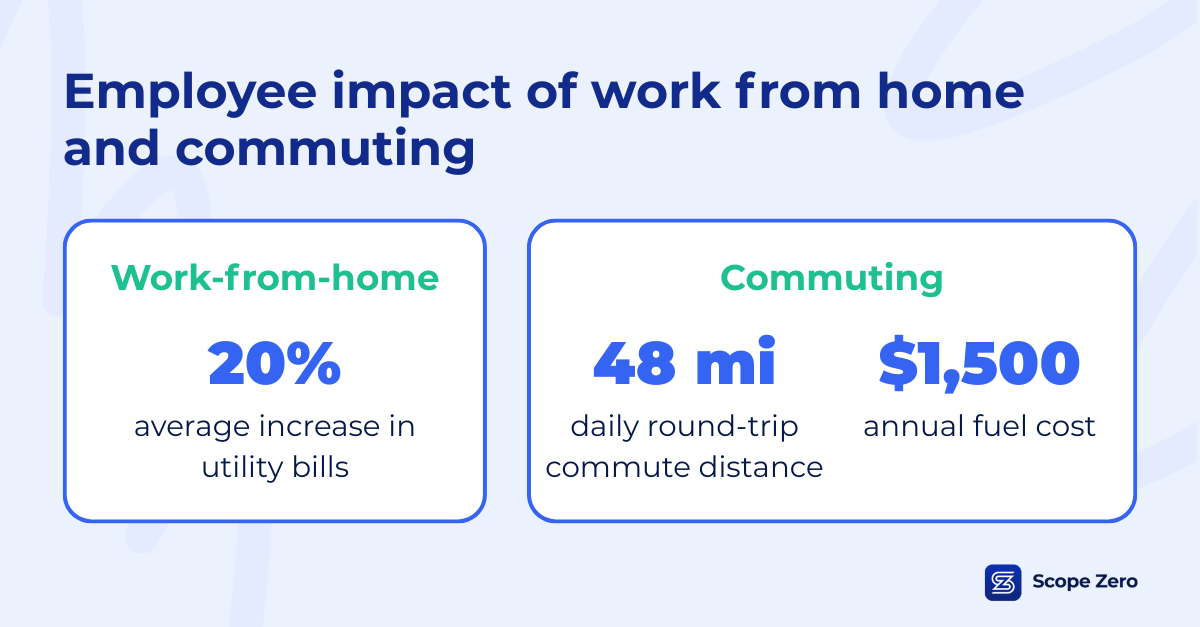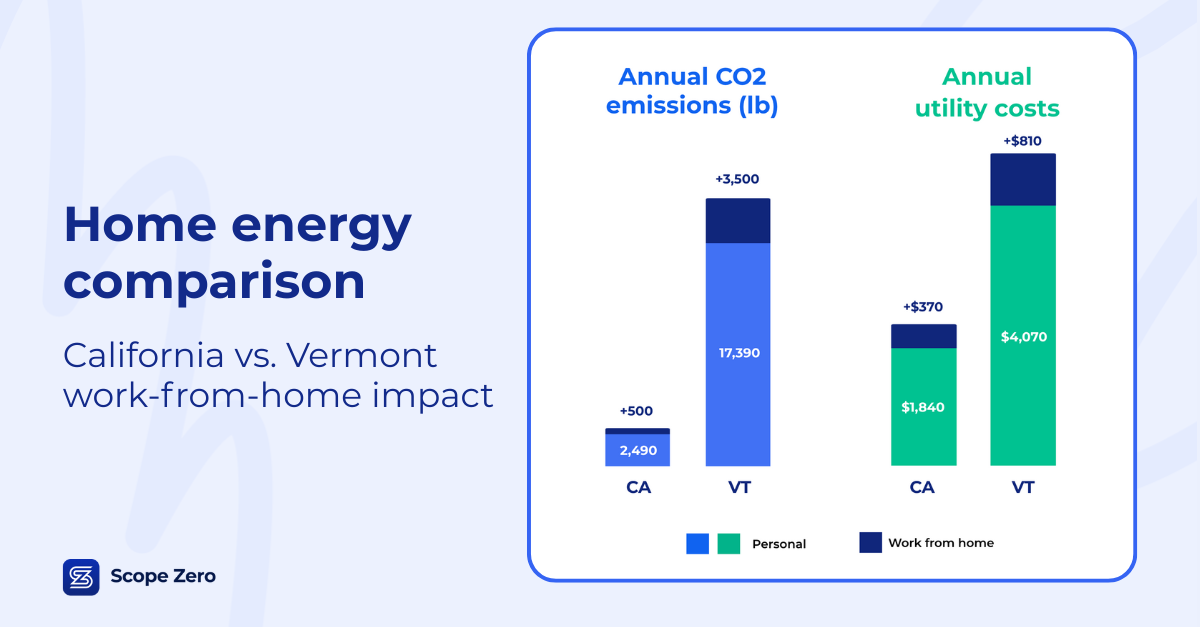Jul 28, 2025 • 8 min read
Scope 3, Category 7: Understanding The Overlooked Piece of Employee Emissions

Scope 3, category 7 emissions are often overlooked or simplified because they’re viewed as difficult to measure, highly variable across individuals, and often seen as less material compared to emissions from supply chains or operations. But ignoring them comes at a cost: missed emissions reductions, untapped financial savings, and a growing blind spot in your sustainability reporting.
In our recent webinar, we unpacked just how significant and nuanced category 7 emissions are — and how addressing them can move the needle not just on climate goals, but also on key business priorities like talent retention, employee engagement, and ESG impact.
Watch the on-demand webinar recording
Watch the full webinar recording to get a deep dive into the complexities (and opportunities) of scope 3, category 7 emissions.

Table of Contents
What are scope 3, category 7 emissions?
Scope 1, 2, and 3 emissions
The Greenhouse Gas Protocol categorizes corporate emissions into three classifications: scope 1, scope 2, and scope 3. Much like how financial accounting categorizes dollars based on their origin, carbon accounting uses these scopes to categorize emissions by source. A pound of carbon is a pound of carbon regardless of its source, but categorizing it helps organizations understand where emissions originate and identify the most effective strategies for reduction.

Scope 3 emissions
Scope 3 encompasses emissions that are not produced directly by the company or from assets it owns or controls, but rather from sources it indirectly influences along its value chain. Because scope 3 emissions aren’t produced by the company, they are more difficult to control or measure. But scope 3 emissions usually account for the majority of a company’s carbon footprint — often representing more than 70% of total emissions, depending on the company, size, and industry.
Scope 3 is subdivided into 15 subcategories, ranging from purchased goods and business travel to the use of sold products or how the company invests their money.
Scope 3, category 7
The GHG Protocol defines scope 3, category 7 as employee commuting.
Category 7 emissions traditionally cover only emissions from travel between home and the office. But the GHG Protocol allows a broader view for category 7 that includes emissions from teleworking (employees working remotely). This includes emissions from energy used for lighting, heating, cooling, electronics, and water during remote or hybrid work. The day-to-day activities associated with remote work are now an important piece to address within a company’s scope 3 carbon emissions.
Category 7 significance
Studies suggest that employee commuting alone can account for 10–15% of a company’s scope 3 emissions. Our own estimates show that for companies like Zillow and EY, combined commuting and work-from-home emissions make up approximately 8% and 13% of their total emissions, respectively.
When you consider the wide range of other emission sources like supply chain operations, office utilities, and product manufacturing, it’s striking that employee commuting still accounts for such a significant share. Yet, emissions from commuting and working from home remain underreported and underserved. Complexity is part of the reason: no two employees have the same commute, home technology, or local utility grid.
As hybrid work has become the norm, so too must a more nuanced approach to understanding and reducing scope 3, category 7 emissions.
The connection between category 7 emissions and financial wellness
Whether an employee commutes to work or works from home, they are met directly with real, recurring costs that impact their wallets every single day.
For remote workers, utility bills rise sharply. Heating, cooling, lighting, and powering home electronics throughout the workday drive up energy use — often increasing monthly utility costs by 20% or more. When you consider that many homes are already inefficient, these added costs create a quiet but growing financial burden on employees.
On the other hand, employees commuting to work face a different kind of cost. With an average roundtrip commute of nearly 50 miles per day for the typical U.S. commuter, the annual fuel cost alone approaches $1,500.
Upgrading home energy efficiency or transitioning to lower-emission commute options not only cuts carbon emissions, it meaningfully reduces cost of living for employees. When companies help employees take these steps, they support both employee financial wellness and climate goals in one unified program.

Measuring category 7: Why traditional methods fall short
Every employee has a different home setup, commute distance, transportation method, and energy usage pattern, making it difficult to create a clear, company-wide picture of commute and work-from-home emissions.
Most companies rely on a simplified, manual process to estimate commute and work-from-home emissions. Typically, this process includes the following steps:
- Send out a simple survey to keep participation barriers low
- Receive responses from employees (sometimes only 5% or less participate)
- Extrapolate from limited data using broad assumptions
- Apply generic emission factors that miss individual nuances
- Struggle to track changes as employees’ commutes and remote work setups change
This approach fundamentally misunderstands the complexity of employee emissions. Generic emission factors can't account for the pronounced differences between individual situations — differences that introduce major blind spots in reporting.
The impact of location and behavior on emissions
To understand why generic, survey-based approaches to measuring category 7 emissions fall short, it’s important to look at just how drastically emissions and their associated costs can vary between employees.
Take this example: two employees, both working remotely full-time. One lives in a typical all-electric home in California. The other lives in a typical home in Vermont that uses both electricity and fuel oil.

While both employees are working the same amount of hours per week from home, their environmental footprints and utility bills are dramatically different. California’s electric grid is powered by a higher share of renewable energy, while Vermont’s grid is more carbon-intensive, and its colder winters drive higher heating demand. Add in the use of fuel oil, one of the most carbon-heavy energy sources, and it’s easy to see why the Vermont home generates significantly more emissions.
The financial impact follows the same trend. When working from home full-time, energy use increases — more lighting, heating, cooling, electronics, and plumbing. This typically results in a 20% spike in utility bills. For the employee in California, that’s about $370 more per year. In Vermont, it climbs to an additional $810 annually.
This example illustrates a key point: location and grid mix matter. A one-size-fits-all emissions factor doesn’t capture these nuances, not to mention the nuances that exist with differences in home technology and employee behavior at home. Accurate, actionable measurement requires granularity, and that’s where most traditional approaches break down.
The Carbon Savings Account®: Turning measurement to meaningful action
Addressing scope 3, category 7 emissions requires more than annual surveys and generic estimates. It demands an employee-centered, data-driven approach that not only measures emissions, but actively reduces them. The Carbon Savings Account® (CSA) transforms static reporting into sustained action by guiding employees through a personalized journey of minimizing their commute and work-from-home emissions.
Here’s how the CSA enables ESG impact:
- Build accurate baselines with real data: When employees enroll in the CSA program, they complete a user-friendly onboarding survey that captures key details about their home and commute. This creates a personalized emissions profile, replacing assumptions with real, individual-level data — improving the accuracy of scope 3 reporting from day one.
- Deliver personalized education: The CSA embeds practical education throughout the platform, helping employees understand how their energy and water use connects to both their carbon footprint and their monthly bills. Recommendations for home and transportation upgrades are customized based on each employee’s home type, location, current technology, and usage habits.
- Motivate broad participation: By focusing on financial wellness, the CSA resonates across employee demographics — renters and homeowners, urban and rural employees alike. Because participation leads to tangible cost savings, engagement reaches the full workforce.
- Lower barriers to action: To accelerate upgrades and impact, the CSA combines employer contributions with available utility rebates and government incentives. This lowers the cost of home and transportation improvements and makes sustainable behavior more accessible to all.
- Track and report impact in real time: As employees make upgrades, the CSA collects product-level data, usage insights, and location-based emissions factors to calculate precise financial and environmental savings. These metrics feed directly into corporate sustainability reporting and help employees see their individual impact.
A lever for climate and culture
Scope 3, category 7 emissions aren’t just a reporting challenge; they’re a strategic opportunity hiding in plain sight. These emissions are large enough to move the needle on climate goals, nuanced enough to require smarter reporting tools, and personal enough to spark real behavior change across your workforce.
The companies that recognize this opportunity and invest in solutions that address both measurement and reduction in commute and work-from-home emissions will find themselves with a powerful advantage: sustainability programs that actually work, employees who are financially better off, and ESG impact that shows up on the bottom line.
Want to learn more? Watch the full webinar recording and see how to turn scope 3 category 7 blindspots into opportunities.
Scope 3, category 7 FAQs
What proportion of total emissions do scope 3, category 7 typically represent?
While the exact proportion varies by company size, industry, and workforce distribution, scope 3, category 7 emissions can represent a notable share of total emissions. On average, employee commuting and work-from-home energy use can account for 10–15% of a company’s scope 3 footprint.
How can companies reduce scope 3, category 7 emissions?
The key to addressing category 7 emissions is a combination of accurate measurement and employee-driven reduction. Traditional approaches, like annual surveys and generic emission factors, often fall short due to low participation and lack of granularity. The most effective strategies focus on collecting granular data on employee commute habits and home energy use, providing education and resources to help employees understand their impact, and offering incentives to make efficiency upgrades more accessible.
Reduce scope 3, category 7 emissions with Scope Zero
Scope Zero’s Carbon Savings Account® (CSA) is a financial wellness benefit that engages employees in corporate sustainability. The CSA provides strong financial incentives for employees to make home technology and personal transportation upgrades that reduce their utility bills and fuel spend — simultaneously helping reduce your company’s scope 3 category 7 emissions.
Schedule a demo to learn how the CSA can transform your approach to scope 3, category 7 emissions.
Join our community
Sign up for our newsletter to stay up-to-date on all things Scope Zero.







 Platform
Platform




